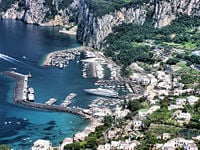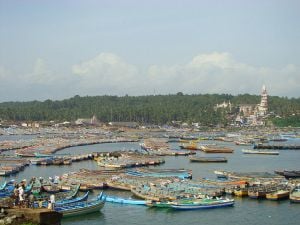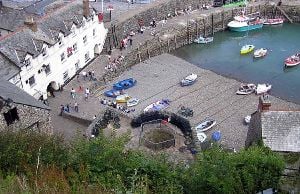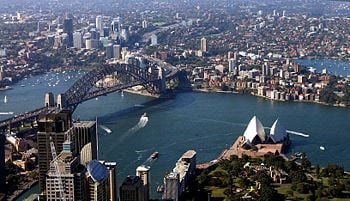Difference between revisions of "Harbor" - New World Encyclopedia
Rosie Tanabe (talk | contribs) |
|||
| (9 intermediate revisions by 3 users not shown) | |||
| Line 1: | Line 1: | ||
| − | [[Image:PortJackson 2004 SeanMcClean.jpg|thumb|right| | + | {{Images OK}}{{Approved}}{{copyedited}} |
| + | [[Image:PortJackson 2004 SeanMcClean.jpg|thumb|right|350px|[[Port Jackson]], [[Sydney]], [[Australia]].]] | ||
| − | A '''harbor''' ('''harbour''' in British English) or '''haven''' is a | + | A '''harbor''' ('''harbour''' in British English) or '''haven''' is a protected body of water that is sufficiently deep to provide ships with shelter from the [[weather]] and to store the vessels. Harbors can be natural or artificial. A natural harbor is surrounded on most sides by land, resulting in calmer waves inside the harbor. An artificial harbor usually has sea walls or [[Breakwater (structure)|breakwaters]] and may require [[dredging]]. |
| − | |||
| − | |||
| + | A [[port]] is often built in a harbor, but every harbor does not have a port. A port is a man-made [[coast]]al or riverine facility where [[boat]]s and [[ship]]s can load and unload passengers and cargo. It may consist of [[quay]]s, [[wharf]]s, [[jetty|jetties]], [[pier]]s, and [[slipway]]s with [[crane (machine)|cranes]] or ramps. A port may also have magazine buildings or warehouses for the storage of goods and a [[transport]] system, such as [[railway]], [[road transport]], or [[pipeline transport]] facilities for relaying goods inland. | ||
| + | {{toc}} | ||
| + | The largest artificially created harbor is in [[Rotterdam]], [[The Netherlands]]. The busiest harbor is the twin [[Port of Los Angeles]] and [[Port of Long Beach]] in southern [[California]] in the [[United States]]. | ||
| + | [[Image:capri.harbour.from.above.arp.jpg|thumb|right|200px|[[Capri]] harbor, [[Italy]], seen from [[Anacapri]].]] | ||
==Natural harbors== | ==Natural harbors== | ||
[[Image:930218630 a6a5d892d0 o.jpg|thumb|A natural harbor in [[Vizhinjam]], [[India]].]] | [[Image:930218630 a6a5d892d0 o.jpg|thumb|A natural harbor in [[Vizhinjam]], [[India]].]] | ||
| − | A natural harbor is a [[landform]] where a part of a [[body of water]] is protected and deep enough to furnish anchorage. Natural harbors have long been of great [[Military strategy|strategic]] and [[economic]] importance. Many of the great cities of the world are located on a natural harbor. Having a protected | + | A natural harbor is a [[landform]] where a part of a [[body of water]] is protected and deep enough to furnish anchorage. Natural harbors have long been of great [[Military strategy|strategic]] and [[economic]] importance. Many of the great cities of the world are located on a natural harbor. Having a naturally protected harbor reduces or eliminates the construction of breakwaters. |
==Ice-free harbors== | ==Ice-free harbors== | ||
| − | + | For harbors near the [[geographical pole|poles]], being [[ice-free port|ice-free]] is an important advantage, ideally all-year round. Examples are [[Murmansk]] ([[Russia]]), [[Petsamo]] (Russia, formerly [[Finland]]), [[Hammerfest]], [[Vardø]], and [[Prince Rupert Harbour|Prince Rupert]] ([[Canada]]). The southernmost harbor, at Antarctica's [[Winter Quarters Bay]] (77°50′S), presents a potentially ice-free harbor, dependent on summer [[pack ice]] conditions.<ref>National Science Foundation, [http://www.nsf.gov/about/budget/fy2000/00OPP.htm U.S. Polar Programs.] Retrieved September 14, 2008.</ref> | |
| − | For harbors near the [[geographical pole|poles]], being [[ice-free port|ice-free]] is an important advantage, ideally all-year round. Examples are [[Murmansk]] ([[Russia]]), [[Petsamo]] (Russia, formerly [[Finland]]), [[Hammerfest]], [[Vardø]], and [[Prince Rupert Harbour|Prince Rupert]] ([[Canada]]). The | ||
==Temporary harbors== | ==Temporary harbors== | ||
| − | [[Image:St. John's, NFLD harbour.jpg|thumb|right|[[St. John's, Newfoundland|St. John's]] harbour, | + | [[Image:St. John's, NFLD harbour.jpg|thumb|right|[[St. John's, Newfoundland|St. John's]] harbour in Newfoundland, Canada.]] |
| − | Sometimes a harbor is needed where one | + | Sometimes a harbor is needed where one is not available because of damage, as in times of war. In such a case, a temporary harbor may be built and transported in segments to the required location. The most notable of these were the two [[Mulberry harbor]]s used during the [[Operation Overlord|D-Day]] invasion of [[Normandy]] in [[World War II]]. |
==Notable harbors== | ==Notable harbors== | ||
| − | [[Image:harbour.clovelly.arp.750pix.jpg|thumb|right| | + | [[Image:harbour.clovelly.arp.750pix.jpg|thumb|right|A tiny harbor at the village of [[Clovelly]] in [[Devon]], [[England]].]] |
The following are large natural harbors: | The following are large natural harbors: | ||
| Line 55: | Line 57: | ||
*[[Wellington Harbour]], [[New Zealand]] | *[[Wellington Harbour]], [[New Zealand]] | ||
*[[Willemstad, Netherlands Antilles|Willemstad]], [[Curaçao]], [[Netherlands Antilles]] | *[[Willemstad, Netherlands Antilles|Willemstad]], [[Curaçao]], [[Netherlands Antilles]] | ||
| − | |||
| − | |||
| − | |||
| − | |||
| − | |||
Other notable harbors include: | Other notable harbors include: | ||
| Line 76: | Line 73: | ||
*[[Portland Harbour]], [[Dorset]], [[England]] | *[[Portland Harbour]], [[Dorset]], [[England]] | ||
*[[Trondheim]], [[Norway]] | *[[Trondheim]], [[Norway]] | ||
| − | *[[Victoria Harbour]] [[Hong Kong]], [[People's Republic of China]] | + | *[[Victoria Harbour]] [[Hong Kong]], [[People's Republic of China]] |
==See also== | ==See also== | ||
| − | |||
* [[Boat]] | * [[Boat]] | ||
| − | |||
* [[Dry dock]] | * [[Dry dock]] | ||
| − | |||
* [[Port]] | * [[Port]] | ||
* [[Ship]] | * [[Ship]] | ||
| Line 91: | Line 85: | ||
== References == | == References == | ||
| − | + | * Dunham, James W., and Arnold A. Finn. 2002. ''Small-Craft Harbors: Design, Construction, and Operation.'' Amsterdam: Fredonia Books. ISBN 1589639650. | |
| − | * Dunham, James W., and Arnold A. Finn. 2002. ''Small-Craft Harbors: Design, Construction, and Operation.'' Amsterdam | + | * Keith, Robert C. 1991. ''Baltimore Harbor: A Picture History.'' Baltimore: Johns Hopkins University Press. ISBN 0801842042. |
| − | |||
| − | * Keith, Robert C. 1991. ''Baltimore Harbor: A Picture History.'' Baltimore | ||
| − | |||
* Roland, Alex, W. Jeffrey Bolster, and Alexander Keyssar. 2008. ''The Way of the Ship: America's Maritime History Reenvisioned, 1600-2000.'' Hoboken, NJ: John Wiley & Sons. ISBN 978-0470136003. | * Roland, Alex, W. Jeffrey Bolster, and Alexander Keyssar. 2008. ''The Way of the Ship: America's Maritime History Reenvisioned, 1600-2000.'' Hoboken, NJ: John Wiley & Sons. ISBN 978-0470136003. | ||
| − | |||
* Whiteneck, Lawrence L., and Lester A. Hockney. 1989. ''Structural Materials for Harbor and Coastal Construction.'' New York: McGraw-Hill. ISBN 0070681538. | * Whiteneck, Lawrence L., and Lester A. Hockney. 1989. ''Structural Materials for Harbor and Coastal Construction.'' New York: McGraw-Hill. ISBN 0070681538. | ||
== External links == | == External links == | ||
| − | + | All links retrieved July 27, 2017. | |
| − | * [http://portfocus.com/united_states_america/index.html Ports of United States of America.] PortFocus | + | * [http://portfocus.com/united_states_america/index.html Ports of United States of America.] PortFocus. |
[[Category:Physical sciences]] | [[Category:Physical sciences]] | ||
Latest revision as of 23:01, 27 July 2017
A harbor (harbour in British English) or haven is a protected body of water that is sufficiently deep to provide ships with shelter from the weather and to store the vessels. Harbors can be natural or artificial. A natural harbor is surrounded on most sides by land, resulting in calmer waves inside the harbor. An artificial harbor usually has sea walls or breakwaters and may require dredging.
A port is often built in a harbor, but every harbor does not have a port. A port is a man-made coastal or riverine facility where boats and ships can load and unload passengers and cargo. It may consist of quays, wharfs, jetties, piers, and slipways with cranes or ramps. A port may also have magazine buildings or warehouses for the storage of goods and a transport system, such as railway, road transport, or pipeline transport facilities for relaying goods inland.
The largest artificially created harbor is in Rotterdam, The Netherlands. The busiest harbor is the twin Port of Los Angeles and Port of Long Beach in southern California in the United States.

Natural harbors

A natural harbor is a landform where a part of a body of water is protected and deep enough to furnish anchorage. Natural harbors have long been of great strategic and economic importance. Many of the great cities of the world are located on a natural harbor. Having a naturally protected harbor reduces or eliminates the construction of breakwaters.
Ice-free harbors
For harbors near the poles, being ice-free is an important advantage, ideally all-year round. Examples are Murmansk (Russia), Petsamo (Russia, formerly Finland), Hammerfest, Vardø, and Prince Rupert (Canada). The southernmost harbor, at Antarctica's Winter Quarters Bay (77°50′S), presents a potentially ice-free harbor, dependent on summer pack ice conditions.[1]
Temporary harbors
Sometimes a harbor is needed where one is not available because of damage, as in times of war. In such a case, a temporary harbor may be built and transported in segments to the required location. The most notable of these were the two Mulberry harbors used during the D-Day invasion of Normandy in World War II.
Notable harbors

The following are large natural harbors:
- Baltimore's Inner Harbor, Baltimore, Maryland, United States
- Boston Harbor, United States
- Charleston, United States
- Cork Harbour, Republic of Ireland
- Durban, South Africa
- Falmouth, Cornwall, England
- Freetown Harbour, Sierra Leone
- Gothenburg, Sweden
- Grand Harbour, Malta
- Halifax Harbour, Nova Scotia Canada
- Kingston, Jamaica
- Kochi, India
- Manila Bay, Philippines
- Milford Haven, Wales
- Montevideo, Uruguay
- Mumbai, India
- New York Harbor, United States
- Oslofjord, Norway
- Pearl Harbor, Honolulu, Hawaii
- Plymouth Sound, Devon, England
- Poole Harbour, Dorset, England
- Port Jackson, Australia
- Port Phillip, Victoria, Australia
- Rio de Janeiro, Guanabara Bay, Brazil
- Salvador, Brazil
- San Diego Bay, San Diego, California
- San Francisco Bay, United States
- Tokyo Bay, Tokyo, Japan
- Trincomalee, Sri Lanka
- Vancouver, Canada
- Wellington Harbour, New Zealand
- Willemstad, Curaçao, Netherlands Antilles
Other notable harbors include:
- Belém, Brazil
- Hamburg Harbour, Germany
- Hampton Roads, Virginia, United States
- Kahului, Hawaii
- Kaipara Harbour, New Zealand
- Kaohsiung, Taiwan
- Keelung, Taiwan
- Keppel Harbour, Singapore
- Manukau Harbour, Auckland, New Zealand
- New Haven Harbor, United States
- Port of Antwerp, Flanders, Belgium
- Port of Bruges-Zeebrugge, Flanders, Belgium
- Portland Harbour, Dorset, England
- Trondheim, Norway
- Victoria Harbour Hong Kong, People's Republic of China
See also
Notes
- ↑ National Science Foundation, U.S. Polar Programs. Retrieved September 14, 2008.
ReferencesISBN links support NWE through referral fees
- Dunham, James W., and Arnold A. Finn. 2002. Small-Craft Harbors: Design, Construction, and Operation. Amsterdam: Fredonia Books. ISBN 1589639650.
- Keith, Robert C. 1991. Baltimore Harbor: A Picture History. Baltimore: Johns Hopkins University Press. ISBN 0801842042.
- Roland, Alex, W. Jeffrey Bolster, and Alexander Keyssar. 2008. The Way of the Ship: America's Maritime History Reenvisioned, 1600-2000. Hoboken, NJ: John Wiley & Sons. ISBN 978-0470136003.
- Whiteneck, Lawrence L., and Lester A. Hockney. 1989. Structural Materials for Harbor and Coastal Construction. New York: McGraw-Hill. ISBN 0070681538.
External links
All links retrieved July 27, 2017.
- Ports of United States of America. PortFocus.
Credits
New World Encyclopedia writers and editors rewrote and completed the Wikipedia article in accordance with New World Encyclopedia standards. This article abides by terms of the Creative Commons CC-by-sa 3.0 License (CC-by-sa), which may be used and disseminated with proper attribution. Credit is due under the terms of this license that can reference both the New World Encyclopedia contributors and the selfless volunteer contributors of the Wikimedia Foundation. To cite this article click here for a list of acceptable citing formats.The history of earlier contributions by wikipedians is accessible to researchers here:
The history of this article since it was imported to New World Encyclopedia:
Note: Some restrictions may apply to use of individual images which are separately licensed.

